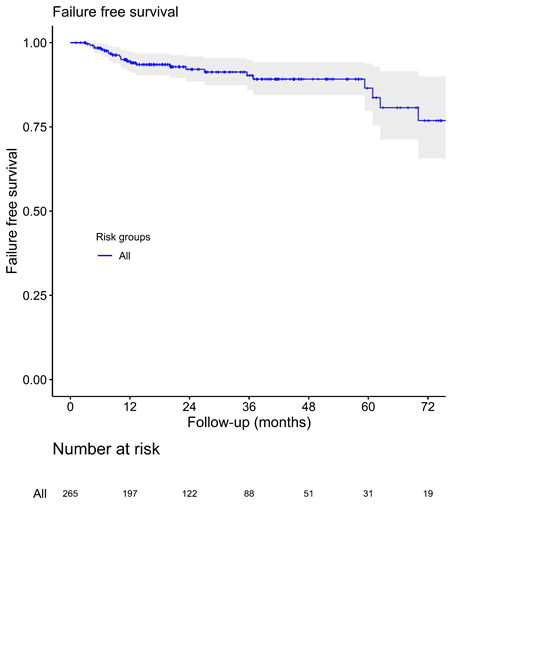Back
Poster, Podium & Video Sessions
Moderated Poster
MP55: Prostate Cancer: Localized: Ablative Therapy
MP55-06: Focal ablative salvage therapy for radio-recurrent prostate cancer: 6 year oncological and safety outcomes
Monday, May 16, 2022
8:45 AM – 10:00 AM
Location: Room 225
DEEPIKA REDDY*, London, United Kingdom, Max Peters, Utrecht, Netherlands, Taimur Shah, London, United Kingdom, Marieke van Son, Utrecht, Netherlands, Mariana Tanaka Bertoncelli, London, United Kingdom, Philipp Huber, Luzern, Switzerland, Derek Lomas, Rochester, MN, Arnas Rakauskas, Lausanne, Switzerland, Saiful Miah, Amersham, United Kingdom, David Eldred-Evans, Stephanie Guillaumier, Feargus Hosking-Jervis, Ryan Engle, London, United Kingdom, Tim Dudderidge, Southampton, United Kingdom, Richard Hindley, Amr Emara, Basingstoke, United Kingdom, Raj Nigam, Guildford, United Kingdom, Neil McCartan, London, United Kingdom, Massimo Valerio, Lausanne, Switzerland, Naveed Afzal, Dorchester, United Kingdom, Henry Lewi, Chelmsford, United Kingdom, Clement Orczyk, Chris Ogden, London, United Kingdom, Iqbal Shergill, Wrexham, United Kingdom, Raj Persad, Bristol, United Kingdom, Jaspal Virdi, Harlow, United Kingdom, Stuart McCracken, london, United Kingdom, Damian Greene, Washington, United Kingdom, Caroline Moore, Manit Arya, Mathias Winkler, Mark Emberton, Hashim Ahmed, London, United Kingdom

Deepika Reddy, MD
Imperial College London
Poster Presenter(s)
Introduction: Radiotherapy is effective in the treatment of non-metastatic prostate cancer. When recurrence occurs, patients are usually managed with watchful waiting and systemic therapy due to significant urinary and rectal morbidity resulting from salvage prostatectomy. Focal ablative salvage therapy (FAST) may provide oncological control with fewer adverse effects. We report on outcomes following FAST using high intensity focused ultrasound (HIFU) or cryotherapy.
Methods: Within the UK’s HEAT and ICE prospective registries, 288 consecutive patients across 8 sites underwent FAST for recurrence after radiotherapy (11/2006-7/2020). 221 (76.5%) underwent HIFU and 67 (23.2%) underwent cryotherapy (for mostly anterior or T3b disease). Follow-up data was available in 265 cases. Primary outcome was failure-free survival (FFS) defined as avoidance of systemic therapy, whole-gland treatment, metastases or prostate cancer-specific death. Secondary outcomes were retreatment- free survival, overall survival and adverse events.
Results: Median (IQR) age was 70 years (66-74) and PSA 5.3ng/ml (3.3-8.2). 188/288 (65.3%) had rT2 and 68 (23.6%) rT3 disease, 105 (36.5%), 89 (30/9%) and 62 (21.5%) had ISUP Grade Group 2, 3 and >3 respectively. Overall median (IQR) follow-up was 23.3 months (12.6- 44.9). FFS (95%CI) at 6 years was 77% (66-90%), respectively [Figure 1]. Retreatment- free survival at 6 years was 77% (66-90%) [Figure 2]. Overall survival (95% CI) at 6 years was 82% (73-94%).
Adverse events were reported in 7.3% (21/288) patients. Overall, 1 (0.3%) was managed for fistula formation, 17 (5.9%) were treated for urine infections, 1 (0.3%) for haematuria managed as an outpatient and 1 for pubic bone osteitis.
Conclusions: Focal ablative salvage therapy for radio-recurrent prostate cancer has low rates of significant adverse events and provides good short to medium-term oncological control.
Source of Funding: no external sources of funding


Methods: Within the UK’s HEAT and ICE prospective registries, 288 consecutive patients across 8 sites underwent FAST for recurrence after radiotherapy (11/2006-7/2020). 221 (76.5%) underwent HIFU and 67 (23.2%) underwent cryotherapy (for mostly anterior or T3b disease). Follow-up data was available in 265 cases. Primary outcome was failure-free survival (FFS) defined as avoidance of systemic therapy, whole-gland treatment, metastases or prostate cancer-specific death. Secondary outcomes were retreatment- free survival, overall survival and adverse events.
Results: Median (IQR) age was 70 years (66-74) and PSA 5.3ng/ml (3.3-8.2). 188/288 (65.3%) had rT2 and 68 (23.6%) rT3 disease, 105 (36.5%), 89 (30/9%) and 62 (21.5%) had ISUP Grade Group 2, 3 and >3 respectively. Overall median (IQR) follow-up was 23.3 months (12.6- 44.9). FFS (95%CI) at 6 years was 77% (66-90%), respectively [Figure 1]. Retreatment- free survival at 6 years was 77% (66-90%) [Figure 2]. Overall survival (95% CI) at 6 years was 82% (73-94%).
Adverse events were reported in 7.3% (21/288) patients. Overall, 1 (0.3%) was managed for fistula formation, 17 (5.9%) were treated for urine infections, 1 (0.3%) for haematuria managed as an outpatient and 1 for pubic bone osteitis.
Conclusions: Focal ablative salvage therapy for radio-recurrent prostate cancer has low rates of significant adverse events and provides good short to medium-term oncological control.
Source of Funding: no external sources of funding



.jpg)
.jpg)